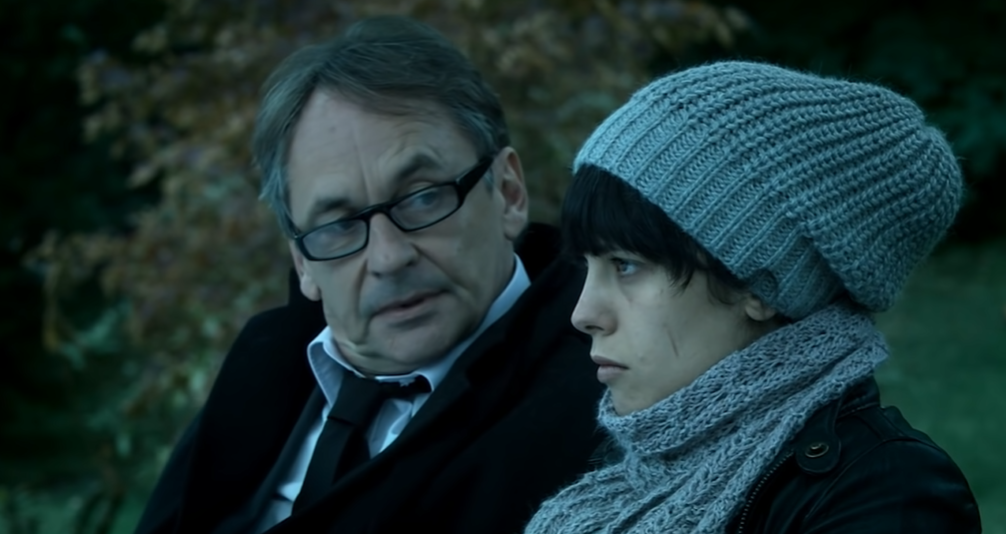Inside
2007

Rated: R
Genre: Thriller, Horror (Extreme Content)
Country: France
Run-Time: 1h 22min
Directors: Alexandre Bustillo, Julien Maury
Cast
Alysson Paradis………..Sarah
Beatrice Dalle……………la femme
France has been home to a number of transgressive films over the last few decades. So much so that in 2004 writer/critic James Quandt termed the phrase “New French Extremity” as an insult towards a large set of films coming out of the country that he felt use cinematic taboos to blur the lines of acceptability by depicting sex and violence in what he believed to be a crude, exploitive manner.
The films Quandt originally first identified were more controversial for their images of graphic sex than their depictions of violence. Only Alexandre Aja’s High Tension is obviously horror. Others are horror in a more unconventional sense. For example, Trouble Every Day and The Skin I’m In are probably better defined as dramas that incorporate body horror, while the horror in a film like Irreversible comes mostly from the graphic nature of its extended rape scene.
At the time these films were made, French directors weren’t trying to be part of a movement. Still, something about Quandt’s article resonated in cinematic circles in a way Quandt never intended. The term of ridicule got embraced. Suddenly, a new generation of French filmmakers emerged looking to gain recognition by fusing more traditional horror with some of the traits Quandt originally identified. The end result has been some of the most creative, influential and graphically violent films of the modern horror horror age.
From this new set of films, which include the likes of Them [Ils], Frontier(s) and Martyrs, I’d argue one of purest examples of New French Extremity is Inside by the writer/ director team of Alexandre Bustillo and Julien Maury.
Inside has the gall to do something that does not get done in horror films: it takes a woman at the end of her pregnancy and makes her the primary victim in a home invasion slasher. And then the film has her poked and cut repeatedly.
The plot of Inside is actually quite simple. Sarah (Alysson Paradis), an expectant mother, gets into a terrible car accident that kills her husband. Months later, Sarah is in the hospital. It is Christmas Eve and a doctor tells Sarah to go home and rest because they will be inducing labour tomorrow.
For a woman about to give birth, Sarah doesn’t seem all that excited about the baby. She misses her husband and has been caught in a spiral of depression her mother can’t snap her out of. Her only remaining friend is her cynical boss who is wise enough to give her space.
In the backdrop, youth immigrant riots are occurring in France. (These are the same real-world riots we see depicted at the start of Xavier Gens Frontier(s)) Two cars in Sarah’s neighbourhood have recently been firebombed and the local suburbanites are a little on edge.
By choice Sarah spends Christmas Eve alone, but at night she gets a knock at the door. A mysterious woman dressed in black (Béatrice Dalle) claims to need help, but considering the recent trouble in the neighbourhood, Sarah knows better than to open the door. So then the woman ups the creepy factor by calling Sarah by name and stating that she knows her husband is dead. Freaky.
The rest of the film is then a violent game of cat and mouse between Sarah and a mystery woman that fixated on getting Sarah’s baby- or at least it should be, except that people keep showing up at the house while Sarah bides time in the bathroom. Considering this is essentially a home invasion film, Inside racks up an impressive body count.
Quandt’s original concern with New French Extremity came from the way these films pushed boundaries of decency and Inside’s exploitive use of a nine-month pregnant protagonist running around in a film full of knives, scissors and broken glass certainly qualifies. And yes, these objects definitely get aimed at Sarah’s belly. It is not that pregnant women haven’t been included in horror films before, think Rosemary’s Baby, but Inside is just so much more visceral. The brutality is savage. Hell, it even includes shots of the helpless fetus responding to the outside dangers. For women- expected mothers in particular- the cringe in these images of violence are on another level.
Inside has earned considerable praise amongst horror fans for the realism of its very graphic gore. (Did I happen to mention that our protagonist is pregnant?) Watching the gradual physical deterioration of both Sarah and our woman-in-black is part of the fun, but it’s in the second act that Bustillo and Maury have a blast sending new victims into their inspired meat grinder. Few films are so beautifully blood-soaked.
Amongst its many other strengths, Inside can boast having one of the best- if not the best- the-killer-is-in-the-house reveals ever. I urge anybody who watches Inside to go back and re-watch this scene. It is amazing cinematography, making use of framing, object placement and shadow to create a shot that is creepy. But the shot is so impressively executed that it is easy to miss the full extent of the creepiness on display on first viewing. It is masterful.
And unlike some of the films within the French Extremity canon, Inside manages to stick the landing. (Looking at you High Tension.) The final minutes of the film leave a lingering, lasting impression. This is how a horror movie should end. It is a pity the 2016 Hollywood remake didn’t have the guts to follow through on it. (The fact that so many people labeled the remake as one of the worst horrors of 2016 is actually further validation of how well regarded within the horror community the French original really is.)
If it wasn’t for Martyrs, I’d probably consider Inside the pride of what I consider the horror wave of New French Extremity. But that is not meant as a dig at Inside as I consider Martyrs to be amongst the best horror films ever made. Inside is a tight film that is paced to perfection. On the surface the story is simple, that is until it gains layers. And the performance of the two lead actresses is superb. (On a side note, Béatrice Dalle also plays the sensual vamp in Trouble Every Day.) But in the end it is the top-notch lighting, cinematography, realistic gore effects and direction that make Inside one of the standout films during a golden age of French horror cinema.
